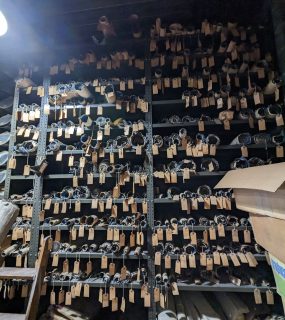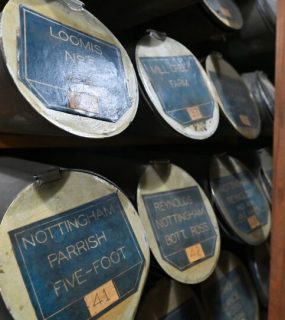News Releases
By Kat Bolus / WVIA News
Find the original story by WVIA.
Inside a red-brick building on Main Street in Ashley, lives the history of one of the largest coal mining operations in the region — Glen Alden and the Blue Coal Company.
The nonprofit that now calls the building home is working with a Bethlehem-based organization to preserve that history.
“This is sort of a really unique institution, that it’s all still here,” said Nick Zmijewski, archivist with Industrial Archives & Library.
Zmijewski’s organization is working with Earth Conservancy to catalogue and preserve around 20,000 linear feet of records — that’s about as tall as Denali, the highest mountain peak in North America.
The Blue Coal Company was the last owner of the storied anthracite mining operation in Luzerne County. They went bankrupt in 1976. Years later, in 1994, then-U.S. Congressman Paul Kanjorski secured a $20 million dollar grant from the Department of Defense to purchase all of Blue Coal’s property, including those offices in Ashley. The purchase also created the nonprofit Earth Conservancy. Their mission is to put the land back into some productive use.
“When Blue Coal actually went bankrupt, they more or less basically picked up and left a lot of their files behind,” said Terry Ostrowski, president and CEO of Earth Conservancy.
Dave Hazel is an archive assistant. He worked in a chilly, dusty room on the building’s second floor. Wearing a mask and gloves, he lightly brushed debris and dust off structural drawings for one of the many buildings owned by Blue Coal. Weights held down the corners to prevent the paper from curling back up into the shape of the tube it had been in for years.
“When Blue Coal actually went bankrupt, they more or less basically picked up and left a lot of their files behind.”
Terry Ostrowski, president and CEO of Earth Conservancy
“Some of these are dating to as far back as early 1900s,” he said.
The records are then wrapped in materials that won’t accelerate the deterioration of the documents.
“Environmentally speaking, things have survived up here very well, compared to a lot of other collections we’ve encountered,” added Zmijewski.
Industrial Archives & Library was founded in 2015. Steve Donches, the founder, president & CEO, was at one time the vice president of Bethlehem Steel. The organization does not archive three-dimensional artifacts.
“Our focus is just on things that don’t cast a shadow essentially,” said Zmijewski.
The coal company documents have sat in cabinets, some which are still locked, and in folders and boxes.
Industrial Archives and Earth Conservancy are working to get a locksmith in to drill out the locks.
There’s a card catalog of alleged accidents and a dismemberment chart that details how much compensation a miner was entitled to depending on the severity of their injury.
The coal company was a huge landowner — so there’s tax and realty records.
Each room provides more historical context but also mystifies both organizations.
“This room is full of boxes returned by the FBI, that have very little rhyme or reason as to their organization,” Zmijewski pointed out.
There’s a Boston phone book from 1978, a Christmas tree stand, a dictaphone and an ashtray from a Playboy Club.
“If you want to do the history of office supplies,” he said. “That’s all here.”
There are details about an explosion in a school. According to the records, dynamite or a blasting cap was mixed in with the coal heating the school.
“Just all sorts of neat little things that color our understanding of what this company did and how it impacted the lives of people, not only locally, but also nationally,” said Zmijewski.
Dusting off History
Anthracite coal mining started in the region in the mid-to-late 1800s.
Originally railroad companies, like the Delaware, Lackawanna and Western Railroad (DL&W), were dominant producers of anthracite at the turn of the century. In 1915, the U.S. Supreme Court ruled the railroad’s ownership of coal properties was an illegal monopoly. So six years later, DL&W sold their coal operation to the Glen Alden Coal Co. Glen Alden at one point owned 14 collieries with a total workforce of 34,000.
As a marketing ploy in a once-competitive industry, Glen Alden tinted its coal blue, claiming the primary-colored rock was a superior product.
In the mid-twentieth century, Glen Alden was the nation’s biggest producer of anthracite coal. Around that time it was taken over in by Albert List, a multimillionaire and an industrialist from New York City. List had previously bought a controlling interest in the film studio, RKO, from film tycoon, aerospace engineer and eccentric millionaire Howard Hughes. RKO was one of the Big Five studios from Hollywood’s Golden Age.
In the late 50s, List transferred the accounting department of RKO from New York City to Ashley.
“There’s RKO personnel records, theater receipts,” said Zmijewski.
Years before the List acquisition, however, in 1937 and 1938, RKO produced a radio drama called “The Shadow.” It starred Orson Welles as the titular character. That show was sponsored by Glen Alden’s blue coal.
Glen Alden was sold to the Blue Coal Company in 1966. Between then and the time it went bankrupt in 1976, it was bought by the Great American Coal Company. Union labor leader Jimmy Hoffa was a silent partner.
“This purchase … was happening right around his disappearance,” said Ostrowski. “So a lot of great, interesting history that’s in this building.”
Present Day
The documents include tons of personnel records. Industrial Archives is currently working on a legal policy for those records.
“The genealogical records are great, but they come with a burden of care and legal standards of personally identifiable information and protecting people’s identities,” said Zmijewski. “There’s a lot of that here that we haven’t encountered in some of our other collections.”
The story of Glen Alden and Blue Coal isn’t as well known as the other Anthracite coal companies, said Zmijewski. It’s been tucked away in the Earth Conservancy office. Archiving it now makes it available for scholars.
Researchers have already reached out on a number of things they’ve come across, including the proposed Conowingo Tunnel.
Between 1944 and 1954, U.S. Bureau of Mines studied digging an over 100-mile tunnel to drain all the anthracite fields into the Chesapeake Bay. The Earth Conservancy headquarters has the correspondences between the various coal companies about the project, which at $280 million was eventually deemed too expensive.
Ostrowski said ultimately they didn’t want to just throw the records away.
“A big interest of ours is maintaining and preserving that history for generations to come,” he said.
Preserving the type of archives that are in Earth Conservancy’s headquarters also helps to understand how the industrial might of the United States helped the country become a world leader, said Zmijewski.
“Steel, coal … all those types of products fueled the Industrial Revolution, they allowed cities to be built, they allowed manufacturing of all types to take off,” he said. “And without understanding how we got to where we are. It’s a lot harder to see sort of where we’re gonna end up.”
Archiving the records is going to take at least a decade.


